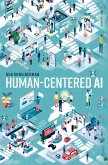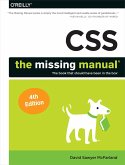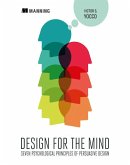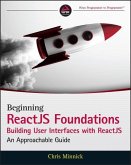Kasper Hornbà k (Professor of Comput Professor of Computer Science, Per Ola Kristensson ( Professor of Interactive Systems Engineering, Antti Oulasvirta (Professor of User I Professor of User Interfaces
Introduction to Human-Computer Interaction
Kasper Hornbà k (Professor of Comput Professor of Computer Science, Per Ola Kristensson ( Professor of Interactive Systems Engineering, Antti Oulasvirta (Professor of User I Professor of User Interfaces
Introduction to Human-Computer Interaction
- Broschiertes Buch
- Merkliste
- Auf die Merkliste
- Bewerten Bewerten
- Teilen
- Produkt teilen
- Produkterinnerung
- Produkterinnerung
This is the first comprehensive textbook for students of human-computer interaction. The book revises and synthesizes topics including design, engineering, empirical methods, and technology. It acknowledges the many challenges that practitioners face and identifies the solution principles that can be used to tackle them.
Andere Kunden interessierten sich auch für
![Human-Computer Interaction Human-Computer Interaction]() I. Scott MacKenzie (Associate Professor of Computer Science and EngHuman-Computer Interaction71,99 €
I. Scott MacKenzie (Associate Professor of Computer Science and EngHuman-Computer Interaction71,99 €![Human-Centered AI Human-Centered AI]() Ben Shneiderman (Emeri Emeritus Distinguished University ProfessorHuman-Centered AI17,99 €
Ben Shneiderman (Emeri Emeritus Distinguished University ProfessorHuman-Centered AI17,99 €![Rxjava for Android Developers Rxjava for Android Developers]() Timo TuominenRxjava for Android Developers22,99 €
Timo TuominenRxjava for Android Developers22,99 €![Css: The Missing Manual Css: The Missing Manual]() David Sawyer McfarlandCss: The Missing Manual37,99 €
David Sawyer McfarlandCss: The Missing Manual37,99 €![Design for the Mind Design for the Mind]() Victor YoccoDesign for the Mind37,99 €
Victor YoccoDesign for the Mind37,99 €![Beginning Reactjs Foundations Building User Interfaces with Reactjs Beginning Reactjs Foundations Building User Interfaces with Reactjs]() Chris MinnickBeginning Reactjs Foundations Building User Interfaces with Reactjs44,99 €
Chris MinnickBeginning Reactjs Foundations Building User Interfaces with Reactjs44,99 €![Learning Blazor Learning Blazor]() David PineLearning Blazor47,99 €
David PineLearning Blazor47,99 €-
-
-
This is the first comprehensive textbook for students of human-computer interaction. The book revises and synthesizes topics including design, engineering, empirical methods, and technology. It acknowledges the many challenges that practitioners face and identifies the solution principles that can be used to tackle them.
Produktdetails
- Produktdetails
- Verlag: Oxford University Press
- Seitenzahl: 864
- Erscheinungstermin: 6. September 2025
- Englisch
- Abmessung: 247mm x 194mm x 45mm
- Gewicht: 1822g
- ISBN-13: 9780192864550
- ISBN-10: 0192864556
- Artikelnr.: 71774621
- Herstellerkennzeichnung
- Libri GmbH
- Europaallee 1
- 36244 Bad Hersfeld
- gpsr@libri.de
- Verlag: Oxford University Press
- Seitenzahl: 864
- Erscheinungstermin: 6. September 2025
- Englisch
- Abmessung: 247mm x 194mm x 45mm
- Gewicht: 1822g
- ISBN-13: 9780192864550
- ISBN-10: 0192864556
- Artikelnr.: 71774621
- Herstellerkennzeichnung
- Libri GmbH
- Europaallee 1
- 36244 Bad Hersfeld
- gpsr@libri.de
Kasper Hornbæk is a Professor of Computer Science at the University of Copenhagen. His core research interests are in human-computer interaction, theories of interaction, user experience, and extended reality. Per Ola Kristensson is a Professor of Interactive Systems Engineering in the Department of Engineering at the University of Cambridge and a Fellow of Trinity College, Cambridge. He leads the Intelligent Interactive Systems group, which belongs to the Engineering Design Centre. He is also a co-founder and co-director of the Centre for Human-Inspired Artificial Intelligence at the University of Cambridge. Antti Oulasvirta is a Professor of User Interfaces in the Department of Information and Communications Engineering at Aalto University. He leads the Computational Behaviour Lab. He is a computational cognitive scientist with an interest in predictive models of human performance in interactive computing.
I Overview of Human-Computer Interaction
1: Introduction to human-computer interaction
II Understanding People
2: Introduction to Understanding People
3: Perception
4: Motor Control
5: Cognition
6: Needs and Motivations
7: Experience
8: Collaboration
9: Communication
III User Research
10: Introduction to User Research
11: Interviews
12: Field Research
13: Survey Research
14: Unobtrusive Research
15: Representations of User Research
IV Understanding Interaction
16: Introduction to Interaction
17: Information and Control
18: Dialogue
19: Tool Use
20: Automation
21: Rationality
22: Practice
V User Interfaces
23: Introduction to User Interfaces
24: Input Devices
25: Displays
26: Interaction Techniques
27: Commands and Navigation
28: Graphical User Interfaces
29: Reality-Based Interaction
VI Design
30: Introduction to Design
31: Design Cognition
32: Design Practice
33: Design Processes
VII Engineering
34: Introduction to Engineering
35: Systems
36: Design Engineering
37: Safety and Risk
38: Software
39: Computational Representations and Models
VIII Evaluation
40: Introduction to Evaluation
41: Analytical Evaluation Methods
42: Think-aloud Studies
43: Experiments
44: Field Evaluations
IX Conclusion
45: Growing into the HCI Discipline
46: Summary: HCI's Principles
1: Introduction to human-computer interaction
II Understanding People
2: Introduction to Understanding People
3: Perception
4: Motor Control
5: Cognition
6: Needs and Motivations
7: Experience
8: Collaboration
9: Communication
III User Research
10: Introduction to User Research
11: Interviews
12: Field Research
13: Survey Research
14: Unobtrusive Research
15: Representations of User Research
IV Understanding Interaction
16: Introduction to Interaction
17: Information and Control
18: Dialogue
19: Tool Use
20: Automation
21: Rationality
22: Practice
V User Interfaces
23: Introduction to User Interfaces
24: Input Devices
25: Displays
26: Interaction Techniques
27: Commands and Navigation
28: Graphical User Interfaces
29: Reality-Based Interaction
VI Design
30: Introduction to Design
31: Design Cognition
32: Design Practice
33: Design Processes
VII Engineering
34: Introduction to Engineering
35: Systems
36: Design Engineering
37: Safety and Risk
38: Software
39: Computational Representations and Models
VIII Evaluation
40: Introduction to Evaluation
41: Analytical Evaluation Methods
42: Think-aloud Studies
43: Experiments
44: Field Evaluations
IX Conclusion
45: Growing into the HCI Discipline
46: Summary: HCI's Principles
I Overview of Human-Computer Interaction
1: Introduction to human-computer interaction
II Understanding People
2: Introduction to Understanding People
3: Perception
4: Motor Control
5: Cognition
6: Needs and Motivations
7: Experience
8: Collaboration
9: Communication
III User Research
10: Introduction to User Research
11: Interviews
12: Field Research
13: Survey Research
14: Unobtrusive Research
15: Representations of User Research
IV Understanding Interaction
16: Introduction to Interaction
17: Information and Control
18: Dialogue
19: Tool Use
20: Automation
21: Rationality
22: Practice
V User Interfaces
23: Introduction to User Interfaces
24: Input Devices
25: Displays
26: Interaction Techniques
27: Commands and Navigation
28: Graphical User Interfaces
29: Reality-Based Interaction
VI Design
30: Introduction to Design
31: Design Cognition
32: Design Practice
33: Design Processes
VII Engineering
34: Introduction to Engineering
35: Systems
36: Design Engineering
37: Safety and Risk
38: Software
39: Computational Representations and Models
VIII Evaluation
40: Introduction to Evaluation
41: Analytical Evaluation Methods
42: Think-aloud Studies
43: Experiments
44: Field Evaluations
IX Conclusion
45: Growing into the HCI Discipline
46: Summary: HCI's Principles
1: Introduction to human-computer interaction
II Understanding People
2: Introduction to Understanding People
3: Perception
4: Motor Control
5: Cognition
6: Needs and Motivations
7: Experience
8: Collaboration
9: Communication
III User Research
10: Introduction to User Research
11: Interviews
12: Field Research
13: Survey Research
14: Unobtrusive Research
15: Representations of User Research
IV Understanding Interaction
16: Introduction to Interaction
17: Information and Control
18: Dialogue
19: Tool Use
20: Automation
21: Rationality
22: Practice
V User Interfaces
23: Introduction to User Interfaces
24: Input Devices
25: Displays
26: Interaction Techniques
27: Commands and Navigation
28: Graphical User Interfaces
29: Reality-Based Interaction
VI Design
30: Introduction to Design
31: Design Cognition
32: Design Practice
33: Design Processes
VII Engineering
34: Introduction to Engineering
35: Systems
36: Design Engineering
37: Safety and Risk
38: Software
39: Computational Representations and Models
VIII Evaluation
40: Introduction to Evaluation
41: Analytical Evaluation Methods
42: Think-aloud Studies
43: Experiments
44: Field Evaluations
IX Conclusion
45: Growing into the HCI Discipline
46: Summary: HCI's Principles








